Does a Flat Continue on After a Marked Note
Accidental Rules #4 – Tied Notes with Accidentals
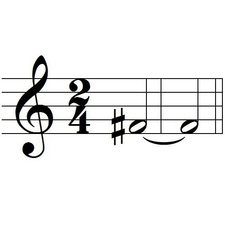
Tied Notes with Accidentals
But what happens when there are tied notes with accidentals?
How is the accidental affected by the tie?
Does the accidental affect the notes after the tie?
If we have a bar line through a tie, does it cancel the accidental? Do we need another accidental on the 2nd note of the tie?
How do we name tied notes with accidentals?
Different Rules for Naming Notes
Lets look at 3 Different Rules
#1 - Rule for Naming Tied Notes:
- the note is only named when it is played (depressed).
#2 - Rules for Naming Notes with Accidentals:
- the accidental applies only to the note on the line or in the space in which it appears.
- the accidental is cancelled by the bar line or by another accidental.
#3 - Rules for Naming Tied Notes with Accidentals:
- the note is only named when it is played (depressed).
- the accidental applies only to the note on the line or in the space in which it appears.
- the accidental is cancelled by the bar line or by another accidental.
Naming Tied Notes with Accidentals - the Bar Line
So - here is the confusing part: Does the bar line cancel the accidental of the tie? Yes it does - but only once the note has stopped being played (depressed).
Okay - let's see if this makes sense. Here in Example #1, name the following notes:
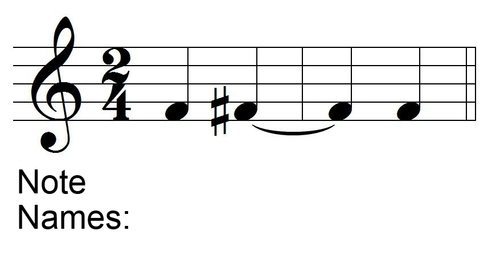
The rule for naming notes with accidentals is that the accidental applies only to the note on the line or in the space in which it appears, and only until it is cancelled by the bar line or by another accidental.
The key here is to remember that a note is named only once at the beginning when it is first played, and the name of the note does not change for as long as the note is depressed (held down or being played).
Therefore, the answer can only be:
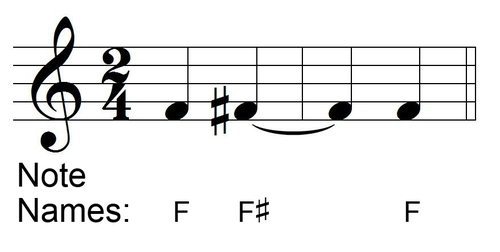
Lets check our "Rules for Naming Tied Notes with Accidentals":
The note is only named when it is played (depressed). Correct. We hear 3 sounds - F (1 beat), F# (1 quarter note tied with another quarter note, or 2 beats) and F (1 beat).
The accidental applies only to the note on the line or in the space in which it appears. Correct. (We are only using the F in space 1.)
The accidental is cancelled by the bar line or by another accidental. Correct. The final note in measure 2 is F (not F#). It does not need a natural sign because the original sharp in measure 1 has been cancelled by the bar line.
Naming Tied Notes with Accidentals - Tie or Slur?
So, how do we know that this curved line is a tie and not a slur? Simple - the curved line is below the noteheads (written closest to the noteheads) and opposite the stems (if stems are ascending, the curved tie line is below; if stems are descending, the curved tie line is above).
While the bar line technically does cancel an accidental, the "Power of the Tie" is stronger. (Insert dramatic Star Wars Type music here).
If the Composer had wanted this to be a slur, there are 2 Options available to show without a doubt that the curved line is a slur and not a tie:
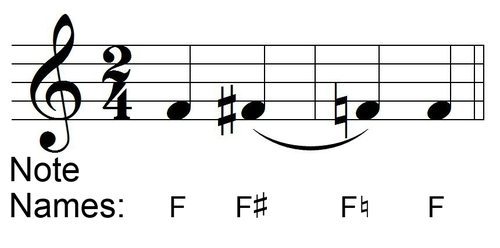
Tied Notes with Accidentals Option #1 - SLUR not TIE:
The composer would put a natural on the second note of the tie.

Tied Notes with Accidentals Option #2 - SLUR not TIE:
The composer would put the curved line above the stems, thus on the OPPOSITE side of the noteheads.
(Remember - a curved line written closest to 2 noteheads in the same space or on the same line is a tie!)
Naming Tied Notes with Accidentals Pop Quiz
Yes, you guessed it - Pop Quiz Time! Can you name the following notes:

Before I give you the answers, I just want to remind you that it is okay to have questions!
When I have a student who questions a concept, my absolute favorite teaching tool is my Ultimate Music Theory Whiteboard.
Sometimes I think that some of my students ask questions about concepts just to see me pull out the whiteboards.
Yes, I am blessed with several "Why" students who are not completely satisfied until I have answered every "Why" or "Why Not" question that they can possibly think of.
And, I think that the mission of a few of them is to "Stump the Teacher" - to find that breaking point where I run out of "answers" and scream "Blame Bach!" while banging my head into the wall and rubbing some "Stress Away Essential Oils" on my wrists, temples and the back of my neck.
So, are you ready for the answer? Here it is:

How did you do? Remember - making mistakes is not a "bad" thing. It is through mistakes that we learn what works for us and what doesn't!
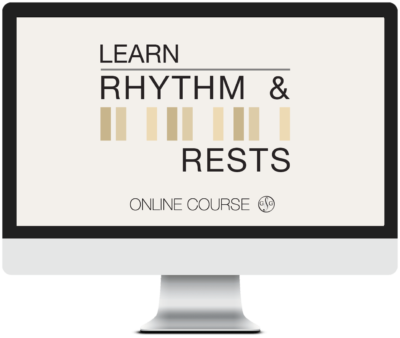
The Learn Rhythm & Rests Online Course is a Step-by-Step System on how to use 4 Effective Ways to Learn Rhythm using the innovative UMT Rhythm & Rests Method.
Learn Rhythm & Rests Course - Online learning includes 8 video sessions covering:
- Beginner Music Theory
- Simple Time
- Compound Time
- Hybrid Time
Plus all your downloadable worksheets with examples and exercises for all 4 music theory levels.
Keep on Learning... With a Smile and a Song!
Shelagh McKibbon-U'Ren
Source: https://ultimatemusictheory.com/tied-notes-with-accidentals/
0 Response to "Does a Flat Continue on After a Marked Note"
Postar um comentário